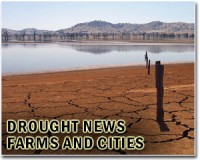| . |  |
. |
Addis Ababa (AFP) Oct 22, 2009 Twenty-five years after Ethiopia's famine killed a million people and spurred a massive global aid effort, the government appealed Thursday for help for more than six million facing starvation. State Minister for Agriculture Mitiku Kassa said the drought-stricken country needed 159,000 tonnes of food aid worth 121 million dollars between now and year's end for 6.2 million people. He said nearly 80,000 children under five were suffering from acute malnutrition and that nine million dollars were required for moderately malnourished children and women. "Since... January, the country continues to face several humanitarian challenges in food and livelihood security, health, nutrition, and in water and sanitation," Mitiku told donors. In a report to mark the 25th anniversary since the 1984 famine, Oxfam called for a change of strategy towards human suffering in Ethiopia, Africa's second most populous country after Nigeria. It urged donors to focus on helping communities devise ways of preparing and dealing with disasters, such as building dams to collect rain water to be used during dry seasons rather than sending emergency relief. Ethiopia adopted a controversial aid law early this year, under which any local group drawing more than 10 percent of its funding from abroad would be classified as foreign and subjected to tight government control. Oxfam said lessons still had to be learned from the 1984 crisis and bemoaned that long-term strategies receive less than one percent of international aid. "Sending food aid does save lives, (but) the dominance of this approach fails to offer long-term solutions which would break these cyclical and chronic crises," said the report: "Band Aids and Beyond." "We cannot make the rains come, but there is much more that we can do to break the cycle of drought-driven disaster in Ethiopia and the Horn of Africa," Oxfam director Penny Laurence said. "Food aid offers temporary relief and has kept people alive in countless situations, but does not tackle the underlying causes that continue to make people vulnerable to disaster year-after-year." Of the 3.2 billion dollars of US aid to Ethiopia since 1991, 94 percent is food which is delivered there rather than grown locally or imported from the region, said the aid group. However, some Ethiopian regions have learnt from the adversity of the 1984 drought and the palliative effects of emergency food aid and turned to modern agriculture for sustenance. "It was horrible. There was nothing I could do to save some of my dying neighbours," recalls 55-year-old farmer Tayto Mesfin in Abay village, some 800 kilometres (500 miles) north of the capital Addis Ababa. "There is nothing worse than food aid, it is never sustainable," said Tayto, standing at the gate of an expansive wheat farm. "If the right methods are practiced, food shortages can be overcome." Abay residents have built silos and farmers have been provided with drought-resistant seeds as well as training with the help of Oxfam. "Drought does not need to mean hunger and destitution," said Lawrence. "If communities have irrigation for crops, grain stores and wells to harvest rains then they can survive despite what the elements throw at them." Although none of Ethiopia's six national droughts since 1984 have been as devastating, aid groups say the grim prospects of food shortages will linger for years to come due to climate change. Average temperatures in Ethiopia are predicted to rise by 3.9 degrees celsius by 2080, Oxfam said, making drought "the norm, hitting the region in up to three in every four years in the next 25 years." Share This Article With Planet Earth
Related Links Climate Science News - Modeling, Mitigation Adaptation
 Somalia's war displaced hard hit by drought
Somalia's war displaced hard hit by droughtGalkayo, Somalia (AFP) Oct 4, 2009 Living in twig and cloth shelters after fleeing raging violence in Mogadishu, a severe drought has worsened the misery of thousands of Somalis settled outside the central town of Galkayo. The prolonged drought affecting millions across war-ravaged Somalia is forcing more people into Margaga camp, which was initially set up to cater for those driven out by the country's relentless clashes. ... read more |
|
| The content herein, unless otherwise known to be public domain, are Copyright 1995-2009 - SpaceDaily. AFP and UPI Wire Stories are copyright Agence France-Presse and United Press International. ESA Portal Reports are copyright European Space Agency. All NASA sourced material is public domain. Additional copyrights may apply in whole or part to other bona fide parties. Advertising does not imply endorsement,agreement or approval of any opinions, statements or information provided by SpaceDaily on any Web page published or hosted by SpaceDaily. Privacy Statement |